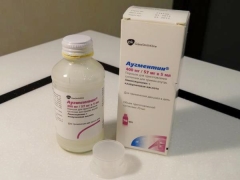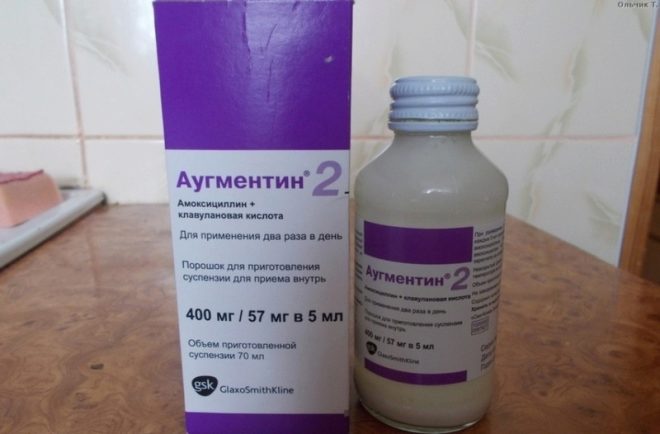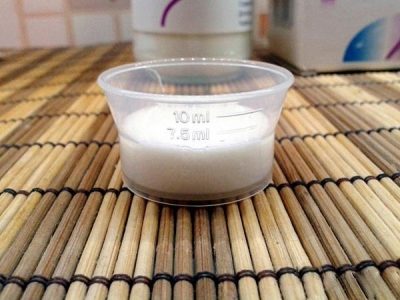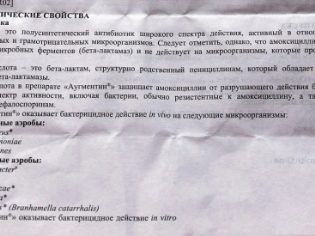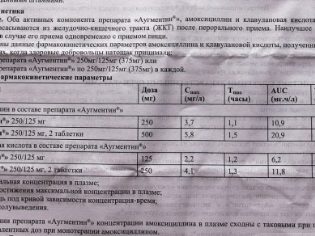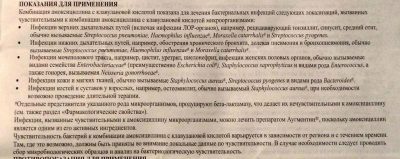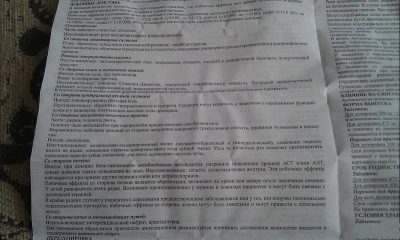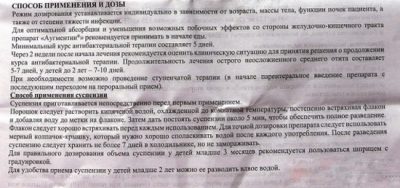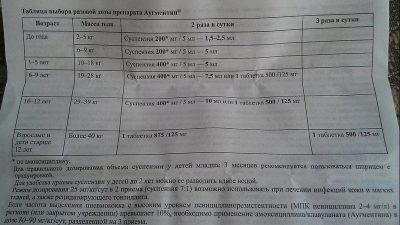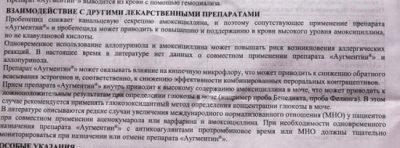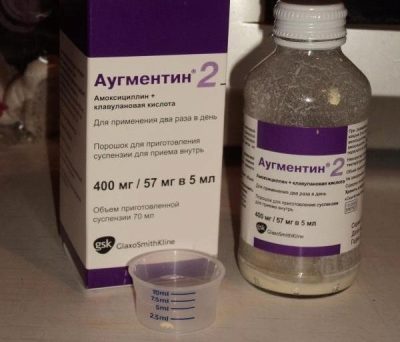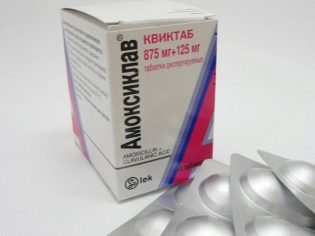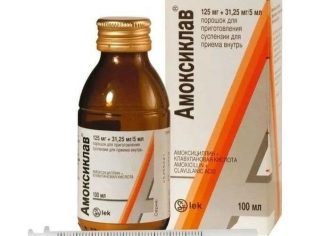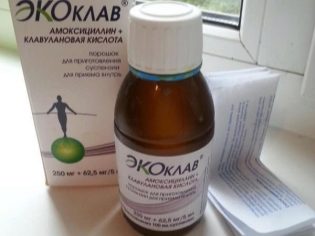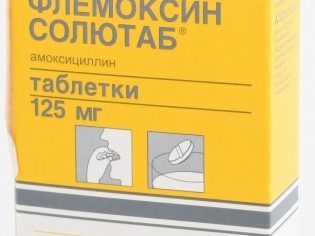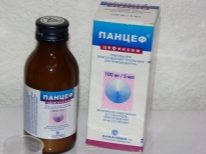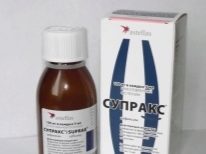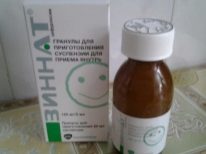Suspension "Augmentin" for children: instructions for use
When choosing an antibiotic for the treatment of an infection, preference is often given to drugs with a broad spectrum of antimicrobial action. One of them is Augmentin. For children, this medicine is more convenient to give in liquid form. When is it prescribed to young children and how is the suspension prepared? Is the drug taken before or after a meal? How long to treat a child? These and other questions interest every mother if her son or daughter has to take an antibiotic.
Release form
Augmentin, from which the suspension is prepared, is represented by a powder placed in a glass vial. Such a powder has a white color and a characteristic odor, and after adding water, a white suspension is obtained from it, which, during storage, stratifies to form a white precipitate. The drug is also available in an injectable form (it is intended for intravenous administration) and in tablets in the shell with different dosages (they can contain 250, 500 or 875 mg of antibiotic each).
Composition
Augmentin includes two active ingredients at once, thanks to which it has a wide range of effects on microorganisms:
- Amoxicillin. This antibiotic is represented by the trihydrate form and is contained in 5 ml of the finished drug at a dosage of 125 mg, 200 mg or 400 mg.
- Clavulanic acid. Such a compound is a potassium salt, and the dosage of this acid is, depending on the dose of amoxicillin, 31.25 mg, 28.5 mg, or 57 mg per 5 ml of suspension.
The ratio of these two components is represented by a ratio of 4: 1 and 7: 1. Additionally, the vial contains silicon dioxide, xanthan gum, hypromellose and succinic acid. For sweetness, aspartame is added to the preparation, and the smell of the suspension is provided by orange, raspberry and molasses flavors.
Operating principle
Amoxicillin in the composition of Augmentina has an antimicrobial effect on many types of microorganisms. It acts bactericidal, causing the death of bacteria due to inhibition of the synthesis of the walls of their cells. However, this antibiotic can be destroyed under the influence of beta-lactamase, so it can not destroy the bacteria that produce such enzymes.
To prevent this destruction, clavulanic acid is present in the preparation. It inactivates beta-lactamase, which makes even amoxicillin-resistant microbes sensitive to suspension.
The drug effectively acts against:
- Different types of staphylococci, including saprophytic and golden.
- Pertussis sticks.
- Different types of streptococci, including hemolytic, pyogenic and group B.
- Nocardium
- Listeria.
- Hemophilic sticks.
- Enterococci.
- Helicobacter pylori.
- Gonokokkov.
- Vibrio cholerae.
- Pasterell.
- Peptococcus and peptostreptokokkov.
- Moraksell.
- Pale treponema.
- Leptospira.
- Borrelia
- Bacteroids.
- Clostridium.
- Fuzobakteriy.
Suspension may be impotent against Escherichia coli, Proteus, Salmonella, Corynebacteria, Pneumococci, Klebsiel and Shigella, therefore, when infected with these microorganisms, it is recommended that you first analyze the sensitivity.
The drug is considered to be ineffective when infected with citrobacter, enterobacter, morganella, providence, legionella, hafnium, pseudomonad, iersinia, chlamydia, coxiella, mycoplasma and serration.In addition, this medicine does not help with flu, herpetic sore throat, SARS, mononucleosis, chickenpox and other viral infections.
Indications
Augmentin in the form of a suspension is administered:
- If the bacteria are affected by the upper respiratory tract and upper respiratory system, for example, otitis media, sinusitis or recurrent tonsillitis.
- With whooping cough or scarlet fever.
- With exacerbation of chronic bronchitis, acute bronchitis, lobar pneumonia and other bacterial lesions of the lower respiratory tract.
- With urinary infections, for example, with urethritis or pyelonephritis.
- With gonorrhea.
- When infected with streptococci or Staphylococcus aureus of soft tissue or skin.
- With bacterial infections of the joints or bones.
At what age is it allowed to take?
Augmentin is prescribed by pediatricians to children of any age, even babies. In this case, suspensions with a dosage of amoxicillin 200 mg or 400 mg per five milliliters do not give babies the first three months of life. Such drugs are prescribed in children only from 3 months.
Contraindications
The drug should not be given to a child with hypersensitivity to any component of the suspension, as well as allergies to other penicillin antibiotics or cephalosporins. Also, treatment is prohibited with phenylketonuria, due to the presence in the composition of aspartame.
Very carefully prescribe medication for children who have impaired kidney function or have liver disease. If infectious mononucleosis is suspected in a baby, Augmentin's use can cause a core-like rash.
Side effects
Due to Augmentin treatment, a child may experience:
- Allergy in the form of itching, urticaria or rash.
- Stool thinning, as well as vomiting or nausea.
- Deterioration of blood counts - a decrease in the level of platelets and leukocytes, sometimes agranulocytosis and anemia, as well as a change in the indicators of the coagulation system.
- Candida infection affecting mucous membranes or skin.
- Enhance the activity of liver enzymes.
- Headache or dizziness.
The very rare side effects of taking the suspension include angioedema, anaphylaxis, nervous agitation, convulsions, intestinal inflammation, stomatitis, discoloration of the tooth enamel, nephritis and other negative phenomena. When they occur, treatment is stopped and immediately go to the doctor.
Instructions for use
To prepare the suspension, boiled and cooled to room temperature water in a certain amount is added to Augmentin powder. In a preparation containing amoxicillin in a dose of 125 mg to 5 milliliters, you must first pour 60 ml of water. Then the medicine is shaken and left for 5 minutes, after which more water is added so that its total volume is about 92 ml.
If a suspension containing 200 ml or 400 mg of amoxicillin in five milliliters is used in the treatment, the powder is first mixed with 40 ml of water, and after five minutes some more water is added to the bottle so that the total amount is about 64 ml.
In addition, treatment with the liquid form of Augmentin provides for such nuances:
- Before each use, the medicine should be shaken so that the separated syrup becomes homogeneous.
- Measuring the exact dose of the medication helps measure the cap, which is attached to the vial of the antibiotic. When the child drank the suspension, this cap is thoroughly washed with water.
- For a child younger than two years of age, a single dosage of the drug can be further diluted with 1: 1 water.
- The mode of use and the calculation of a single dosage of the drug are affected by both the child’s age and weight, the condition of the kidneys, and the severity of the infection.
- So that the active substances of the medication are optimally absorbed, and the risk of side effects is less, the medicine is advised to drink at the beginning of the meal. For nursing infants, the suspension is given during feeding.
- How many days to drink the drug, in each case is determined individually, but the minimum course of treatment is considered to be a period of 5 days.In addition, it is undesirable to give a suspension longer than 14 days.
- To prevent staining of the teeth, it is recommended to thoroughly clean them several times a day.
Dosage
The babies of the first three months of life are given only a suspension, the active substances of which are presented in a 4: 1 ratio (125 mg / 31.25 mg).
To calculate the daily dose of medication, you need to know the weight of the infant in kilograms. It is multiplied by 30 and get the number of milligrams of amoxicillin. By dividing the resulting figure by 2, determine a single amount of ml of suspension, which is given to the child twice a day.
A child aged 3 months to 12 years, which weighs less than 40 kilograms, the suspension is dosed as follows:
- Drug containing active compounds 125mg / 31.25mg give three times a day with an interval of 8 hours between doses.
- A medicine containing active ingredients in an amount 200mg / 28.5mg either 400mg / 57mg, prescribed twice, that is, such suspensions are taken twice a day.
If a child soft tissue or skin infection, then Augmentin is prescribed in a low dose. It is represented by 20 mg per 1 kg of baby weight per day for a suspension of 125 mg / 31.25 mg / 5 ml or 25 mg per day per kilogram of child weight for suspensions with a 7: 1 ratio of active ingredients. The same dosing is used with relapses of tonsillitis.
If Augmentin treat otitis, sinusitis, infections of the joints, urinary organs, lower respiratory tract or bones, apply high doses. This is 40 mg per 1 kilogram of body weight of the child per day for a 4: 1 suspension. If the baby is given a drug of 7: 1, then the dosage will be 45 mg per day per 1 kg of patient weight. All calculations are performed on amoxicillin.
Children over 12 years old and children over 40 kg give 11 ml of suspension containing 400 mg of amoxicillin and 57 mg of clavulanic acid. The drug is administered twice. It should be noted that in such patients it is more preferable to use the drug in tablet form.
Overdose
If you exceed the prescribed dose of the suspension, it can disrupt the child's digestive system and affect the water-electrolyte balance in his body. It is also possible the formation of crystals in the urine, because of which an overdose can provoke renal failure. If the child has diseased kidneys, then overdosing can cause seizures.
Interaction with other drugs
- Combined use with antacids, laxative drugs or glucosamine worsens the absorbability of amoxicillin.
- At simultaneous appointment with macrolides (for example, with suspension Sumamed or Azitrox) Augmentin action will be weaker. The same effect is observed when combined with tetracyclines, sulfonamides, linkosamides and chloramphenicol.
- Suspension can be used with nitrofurans, for example, drug Enterofuril.
- You should not give the child Augmentin with allopurinol, as this combination can provoke skin allergies.
- When prescribed with anticoagulants (indirect), the effectiveness of these drugs will increase.
- The drug is not prescribed together with methotrexate, since penicillins increase its toxicity.
Terms of sale
To buy powder in a pharmacy, you first need to get a prescription from a doctor. The price of one bottle depends on the dosage and can vary from 130 to 250 rubles.
Storage features
An unopened vial of powder can be stored until the end of its 2-year shelf life, in a dry place away from children, in which the temperature does not rise above +25 degrees. Diluted with water, the drug should be placed in the refrigerator, but at the same time prevent freezing of the solution. The shelf life of liquid medicine is 7 days.
Reviews
Most of the feedback from parents about Augmentin suspension is positive. Moms say that such an antibiotic helps to cope with many infections and is well tolerated by most children.They confirm that the treatment starts to act quickly at high temperature, cough and other symptoms of infection. Within a few days from the beginning of the reception, the child's condition improves.
In the negative reviews complain about the side effects of the drug, such as nausea or diarrhea. Pediatricians, among whom Komarovsky, speak about this antibacterial agent mostly well, but they emphasize that only a doctor should prescribe this suspension to the child.
Analogs
Replace liquid Augmentin can other drugs containing a combination of "amoxicillin + clavulanic acid." In the form of suspensions are produced Amoxiclav, Medoklav, Panklav 2X, Ecoclav, Augmentin EC, and Amoxiclav Quiktab is produced in the form of soluble tablets and Flemoklav Solyutab.
The doctor may also prescribe amoxicillin-based preparations for the child (suspension Amosin, pills Flemoxine Solutab or suspension Hikontsil) or drugs in the form of a suspension from the group of cephalosporins (Suprax, Pancef, Zinnat other).
At the same time, it is only a pediatrician who can decide what is best suited as Augmentin's substitute. A good specialist will take into account the clinical picture and tests for sensitivity to antibiotics, and then prescribe the correct treatment.
In the following video, the popular children's doctor Komarovsky tells in detail about antibiotics, what they are for and when they are used.
